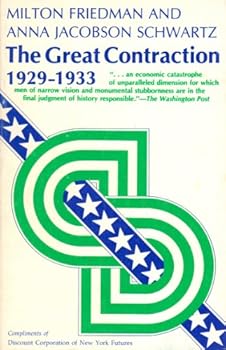The Great Contraction, 1929-1933
Select Format
Select Condition 
Book Overview
The description for this book, The Great Contraction, 1929-1933, will be forthcoming.
Format:Paperback
Language:English
ISBN:0691003505
ISBN13:9780691003504
Release Date:February 1965
Publisher:Princeton University Press
Length:150 Pages
Weight:0.40 lbs.
Customer Reviews
2 ratings
Truth vs. History
Published by Thriftbooks.com User , 15 years ago
Milton Friedman was a true genius of conservative economics. A great vehicle for understanding the great depression or the current (2009) financial crisis.
The Monetary History of the Great Depression
Published by Thriftbooks.com User , 23 years ago
The Great Contraction is an expanded reprint of the seventh chapter of the authors' A Monetary History of the United States, 1867-1960 which was first published in 1963. That monograph was a comprehensive study of money and its effects on the economy and the nation. It was one of the most important works of economics ever written; so well regarded, in fact, that it contributed to Dr. Friedman's winning of the Nobel Prize in Economic Sciences in 1976.Milton Friedman is one of the most eminent economists of the twentieth century. His pioneering efforts in the field of monetarism revolutionized the way that economists thought about and studied the economy. (In short, monetarism emphasizes the role of money, especially the supply of money, in the functioning of the economy. This is contrasted with Keynesian economics which gives central importance to expenditures, particularly government expenditures.)The basic premise of The Great Contraction is that the economic and financial collapse that occurred between 1929 and 1933-the most severe business cycle contraction in United States history-was largely the result of the inept application of monetary policy by the Federal Reserve System. The Federal Reserve had ample power to stop the devastating process of monetary deflation and the collapse of the banking system. Had they used that power in late 1930 or even in early or mid-1931, the successive crises that typify the contraction could almost certainly have been prevented. Appropriate action would have lessened the severity of the contraction and probably brought it to a much earlier end.The most important contributing factor to the contraction, the authors believe, was the drastic reduction in the supply of money. From 1929 to 1933, the money stock fell by 33 percent, a continuous annual rate of 10 percent. This had a devastating effect on the economy. When the money supply decreases, the amount of funds available for loans decreases. This causes interest rates to rise, making it more expensive for businesses and individuals to borrow money, and, consequently, making them decrease expenditures on consumption and investment. This results in the economy shrinking.During the contraction of 1929-1933, however, the effects were even more severe. Due to the huge decrease in the money stock, banks were unable to acquire enough high-powered money (vault cash plus funds on deposit at the Federal Reserve) to meet the demands of depositors. This forced banks to liquidate their assets at deep discounts in order to remain open. This was a dire short term remedy that wreaked havoc not only on the banks' balance sheets, but on the bond markets as well. The rapid selling off of assets, usually corporate or government bonds, drove prices through the floor which added to the panic in the financial markets.When their level of assets dropped low enough, or they were unable to obtain enough funds, banks were forced t





